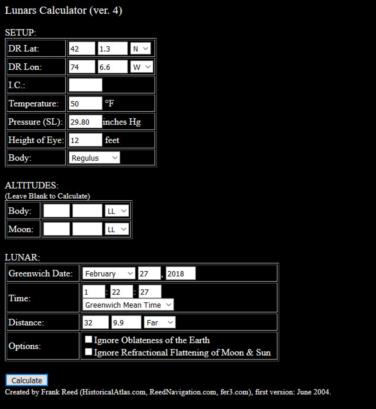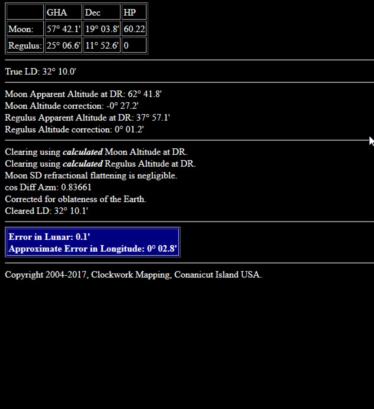
NavList:
A Community Devoted to the Preservation and Practice of Celestial Navigation and Other Methods of Traditional Wayfinding
From: Ed Popko
Date: 2018 May 2, 10:01 -0700
In reading past archive posts on Lunars, I came across an old thread discussing how LOPs can be derived from a lunar observations. The fact that a Lunar can be taken with no horizon makes this a useful method. How often do you have a clear sky but poor visibility of the horizon? It seems worth knowing about. And of course, if you can derive a LOP, you are likely to have other information from your DR or sights to derive a fix.
I could not find a worked example but found enough information to understand the drift of the technique. Frank’s Lunars Calculator makes short work of testing the method.
Attached is my attempt to see how this works.
Basic Lunar Distance Sight
Moon-Regulus (far limb)
February 27, 2018
Known Position Lat 42°01.3’N Lon 074°06.6’W
WE=0”
IE=0.1’ IC=-0.1’
Moon age 11.1 days, waxing gibbous
HP=60.22’ SD=16.4’
LDo 32°09.9’ corrected for IC
Method Used
Based on the above observed lunar, the Lunar Calculator finds:
True LD=32°10.0’
Cleared LD=32°10.1’
Error in Lunar=0.1’
See attached screen captures.
After clearing the initial lunar, I created a box around my Known Position based on the four plot sheet corners (rounded, plus/minus 30’ lat/lon) and reran the Lunar Calculator for each corner holding everything else constant (time, LD observed, body etc.). I marked the computed Lunar Error (LDe) at each corner. See the attached Small Area Plot Sheet. The dot “MAV” marks my known position. It’s Lunar Error, 0.1’, is also marked.
Next, I found two points where the sign of the Lunar Error changes from plus to minus and marked them on latitude 41°30’ and 42°30’ lines. These points were trivial to find; they are marked and the resulting LOP is plotted:
Lat 41°30.0’N Lon 073°56.0’W
Lat 42°30.0’N Lon 074°00.0’W
To test this LOP, I reran the Lunars Calculator for the two sign-changing LOP points and the resulting Error in Lunar was 0.0’ as expected. I picking other convenient points along the LOP, reran them and always the Lunar Error was 0.0’.
I’m not sure I have the procedure totally correct for deriving a LOP from a lunar observation but it looks close.
If anyone has derived LOPs from their lunars, I would appreciate any comments or observations.
Ed Popko








